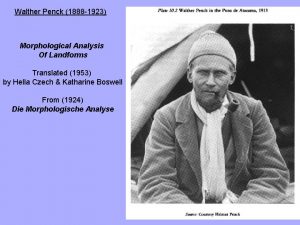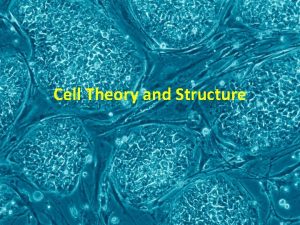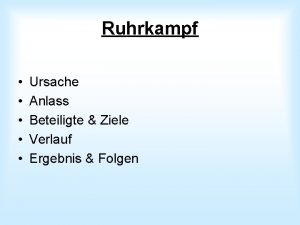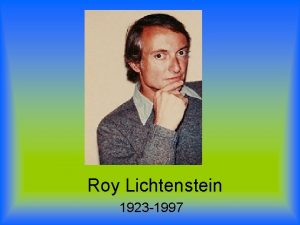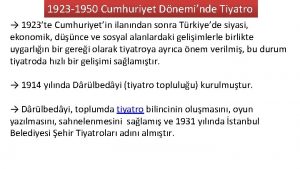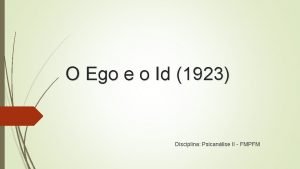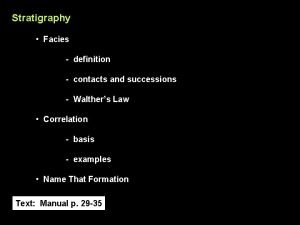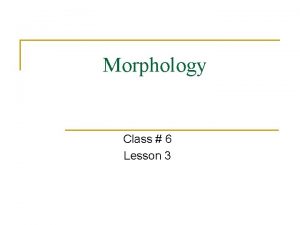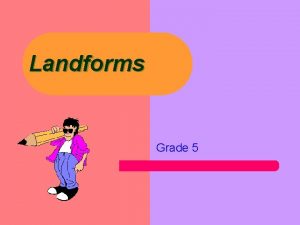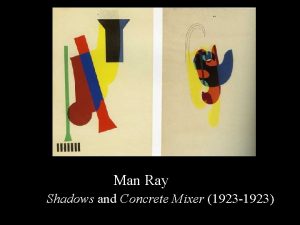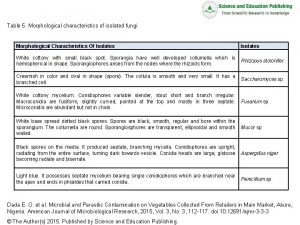Walther Penck 1888 1923 Morphological Analysis Of Landforms



























- Slides: 27

Walther Penck (1888 -1923) Morphological Analysis Of Landforms Translated (1953) by Hella Czech & Katharine Boswell From (1924) Die Morphologische Analyse

Walther Penck (1888 -1923) Born in Vienna (1888) Son of Albrecht Penck

Walther Penck (1888 -1923) Born in Vienna (1888) Son of Albrecht Penck Professional Activities University of Berlin University of Heidelberg Studied in Vienna Direccion General de Minas (Buenos Aires) Served with Germans in Alsace Leipzig University of Constantinople (Istanbul) Professorship at Agricultural College of Halkaly Professor at University of Leipzig (unpaid) *all before the age of 35 Der sudrand der Puna de Atacama (1920) based on 1912 field work Morphological Analysis published posthumously

Walther Penck (1888 -1923) Morphological Analysis Of Landforms Translated (1953) by Hella Czech & Katharine Boswell From (1924) Die Morphologische Analyse

1. Nature of the Problem 2. 2. Basis, Nature and Aim of Morphological Analysis The Problem • study of morphology goes beyond limits of geography • need to understand forces that produce land forms • ‘problem’ is that of crustal movement 3 elements forming the substance of geomorphology 1. Exogenetic Activity (destructive) - reduction and removal of rock - transport of sediment from higher to lower (gravity) - remove uneveness that endogenetic forces cause - require a surface to attack Earth sculpture is due to exogenetic transference of material. The sum total of this constitutes denudation. ” 2. Edogenetic Forces (constructive) - originate within planet - creates relief and uneveness - independent of gravity forces (really? ) - all we know about them is from the effects they have produced 3. Earth’s surface - “is a limiting surface between different forces working in opposition to one another”

1. 1. Nature of of the Problem/ Problem 2. 2. Basis, Nature and Aim of Morphological Analysis Morphological Study Seeks to understand the interaction between three factors (endogenetic, exogenetic, landforms) “Therefore it is possible to see plainly in the forms of denudation not merely the results of endogenetic and exogenetic transference of material; but even more that they owe their origin and their development to a relationship of forces, to the ratio of intensity between exogenetic and endogenetic processes. Discussion Point “Crustal movements cannot be observed directly, and no adequate tectonic method is known for ascertaining their characteristics. Thus in studying land forms, it is not permissible to make definite assumptions as to their course and development, and to base morphogenetic hypotheses upon them. ” “Morphological analysis is this procedure of deducing the course and development of crustal movements from the exogenetic processes and the morphological features. ”

3. 3. Critical Survey Of of Methods Penck on Davis So what were Penck’s beefs with Davis? - does not include endogenetic processes - rapidly uplifted during which no denudation processes occur - once denudation processes begin, block remains at rest (uplift and denudation are NOT successive processes) - applying a ‘special case’ as a ‘general rule’ - followers only see landforms as a realization of the cycle (misunderstanding Davis? ) (b) facts on which the assumptions are based (a) deduction as a method of morphological research What are the main flaws Penck sees in the cycle of erosion? What, if anything, did Davis get right? How were Davis and Penck’s approaches to describing landscape development/processes fundamentally different?

3. 3. Critical Survey Of of Methods Davis on Penck “He seems first to misunderstand a general scheme for a very limited, rigid, spechal scheme; and second equally determined to show the work of an earlier time than his ought to have been done. You do not mention A. Penck, …. the father is as exasperating as the son. ” Excerpt from Chorley et al (1991) History of the Study of Landforms Or the Development of Geomorphology

3. Critical Survey of Methods 4. (b) Relationship between endogenetic and exogenetic processes …it is essential, when investigating the origin and development of denudational forms as they appear at the earth’s surface, to ascertain the relationship between the intensity of the endogenetic and of the exogenetic processes, in short, between uplift and denudation; and it is necessary to follow out how this changes as time goes on. ” What is his thought process leading up to this? “So long as uplift is at work, denudation cannot be idle. ” “…the fundamental law of morphology: the modeling of the earth’s surface is determined by the ratio of the intensity of the endogenetic to that of the exogenetic displacements of material. ” “But the relationship is not an unchanging one. ” “…exogenetic happenings is subordinate to that of endogenetic processes” “Any change in kind or in intensity which these movements undergo must therefore – as has long been known – leave its traces upon the landscape. ”

3. Critical Survey of Methods 4. (c) The Differential Method cycle of erosion

Penck’s Key Points from Introduction - Uplift and denudation are NOT successive processes; denudation is concurrent with uplift - Crustal processes are important (but not observable…) - Ratio of the intensity of endogenetic and exogenetic processes is key - These intensities are constantly changing - There is no one successive generation of landscape forms

Chapter 6: 6: Development of of Slopes SUMMARY OF SLOPE DEVELOPMENT SECTIONS 1. Form of slopes 2. The case of no incision (flattening of slopes) 3 -7. The case of active incision Ratio of erosion intensity to denudation intensity

Chapter 6: Development of Slopes 1. Gradient and Form of Slopes

Chapter 6: Development of Slopes 2. Flattening of Slopes In the case of the cessation of incision (erosion), denudation proceeds…. . Cliff-slope recedence and the development of the basal slope

Chapter 6: Development of Slopes 2. Flattening of Slopes “It is now quite clear that the process obeys a law: Flattening of slopes always takes place from below upwards” (p. 138) “If left undisturbed, a slope of any gradient whatsoever, provided it is uniform, becomes a slope system concave in profile” (p. 140) Cliff-slope recedence and the development of the basal slope and diminishing slope

Chapter 6: 6: Development of of Slopes SUMMARY OF SLOPE DEVELOPMENT SECTIONS 1. Form of slopes 2. The case of no incision (flattening of slopes) 3 -7. The case of active incision Ratio of erosion intensity to denudation intensity

Chapter 6: 6: Development of of Slopes Slope Development Summary All slopes form at the local base level and propagate upwards 2. Erosion intensity controls gradient! Convex slope = increase in erosion intensity (p. 150) Concave slope = decrease in erosion intensity Straight slope = no change Amount of concavity or convexity indicates the rate of change

Chapter 6: 6: Development of of Slopes Questions Q: How does Penck’s model of slope development compare to that of Davis?

Chapter 6: 6: Development of of Slopes Questions Q: Does Penck’s discussion of slope development follow the methodological theory he used to criticize Davis’ work (i. e. , inductive vs. deductive)? How does Penck rely on observation? “It is now possible to give a complete survey of the origin and development of slopes” p. 177

Chapter 6: Development of Slopes 4. Straight slope profiles. Uniform development. (p. 143) The cliff will recede from the river as the basal slope and diminishing slope form UNLESS there is…. . “a constant ratio between the intensity of the denudation acting on the slope unit and the intensity of erosion by the stream”.

Chapter 6: Development of Slopes 4. Straight slope profiles. Uniform development. “If uniform development lasts sufficiently long, straight slope units are produced in every case. ” (p. 148)

Chapter 6: Development of Slopes 5. Convex breaks of gradient (p. 150)

Chapter 6: Development of Slopes 7. Rates of Growth and Areas of Slope Units Erosion intensity increasing over time…. . Intermediate slope units vanish as higher gradient slopes grow more quickly Results in more sharply convex breaks in gradient

Chapter 6: Development of Slopes 7. Rates of Growth and Areas of Slope Units Erosion intensity continually increasing over time.

Chapter 6: Development of Slopes 8. Rise in the general base level of denudation (p. 161)

Chapter 6: Development of Slopes 9. Influence exerted by rocks of heretogeneous character upon the development of slopes

Chapter 6: Development of Slopes 9. Influence exerted by rocks of heretogeneous character upon the development of slopes
 Fluvial cycle of erosion by davis and penck
Fluvial cycle of erosion by davis and penck Why did rizal choose morga?
Why did rizal choose morga? Mayo 5 1888
Mayo 5 1888 Legge di walther
Legge di walther Riforma gentile 1923
Riforma gentile 1923 Lei eloy chaves 1923
Lei eloy chaves 1923 Puntos de control del ciclo celular
Puntos de control del ciclo celular 1-800-928-1923
1-800-928-1923 Walther flemming
Walther flemming Walther flemming
Walther flemming Ruhrkampf verlauf
Ruhrkampf verlauf Roy lichtenstein (1923-1997)
Roy lichtenstein (1923-1997) Minnesänger walther von der vogelweide
Minnesänger walther von der vogelweide John venn (1834-1923)
John venn (1834-1923) Cumhuriyet dönemi'nde tiyatro 1923 1950
Cumhuriyet dönemi'nde tiyatro 1923 1950 O ego e o id (1923 resumo)
O ego e o id (1923 resumo) Henryk żeglarz ur 1923
Henryk żeglarz ur 1923 Exodo 20:11
Exodo 20:11 1923 1924
1923 1924 Ruhr crisis 1923
Ruhr crisis 1923 Hollywoodland 1923 larry
Hollywoodland 1923 larry Walther law of facies
Walther law of facies Unbelievable affix
Unbelievable affix Morphological analysis of words example
Morphological analysis of words example Stylistic colouring
Stylistic colouring Acute suppurative appendicitis
Acute suppurative appendicitis Polysynthetic language
Polysynthetic language Morphological examples
Morphological examples
